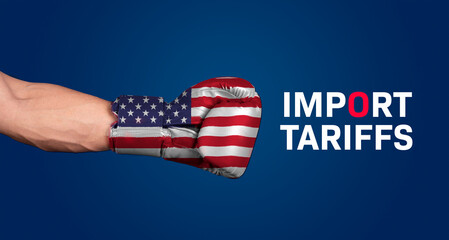
New tariffs are hitting ecommerce businesses, which could lead to profit losses, supply chain disruptions, and potential price hikes for online shoppers.
Price has been the deciding factor for many online shoppers choosing between Amazon and low-cost rival Temu. According to an Omnisend study, while only 5% of consumers say they trust Temu, 53% still shopped there in the past year, mainly driven by the promise of savings, averaging 40% or about $13.37 per product.
But that price gap may not hold for long. With the Liberation Day tariffs from President Trump targeting a broader range of global imports, ecommerce platforms that rely on international supply chains, including Temu and Amazon, are preparing for rising costs.
While Chinese goods are a major focus, products from other key sourcing countries may also face higher duties. As import expenses climb and product prices follow, shoppers may rethink where and how often they click “buy.”
Higher import costs are trickling down to consumers and sellers alike. How should ecommerce companies cope, and what does this mean for the future of online shopping?
The Guardian"Companies with suppliers in Asian countries are likely to have to raise prices after the US president’s measures."
Tariffs are hitting ecommerce businesses with a looming profit reduction
Reports indicate a potential significant profit reduction for Amazon due to the newly implemented tariff on all imports. Amazon could lose up to $10 billion in profits due to the new tariffs, according to a Yahoo Finance report, underscoring the immediate financial risks for major online retailers.
Further corroborating this, a CoinCentral article, cites estimates from Goldman Sachs analysts projecting a potential $5 billion to $10 billion annualized operating profit loss for Amazon. This significant decrease in profit is attributed to higher merchandise costs resulting directly from the tariffs.
Despite the ongoing success of Amazon’s Prime subscription service, the projected $10 billion profit loss highlights the significant financial strain caused by the new tariffs. The scale of the impact signals that these are not minor cost shifts but a serious challenge to profitability across the ecommerce sector.
Impact of tariffs: Increased costs and pricing pressures for third-party sellers
Third-party sellers operating on ecommerce platforms are also feeling the pinch from the newly implemented tariffs. Amazon sellers who import their inventory from affected countries will face a direct increase in their costs, as tariffs are essentially additional taxes on these imported goods.
Many private-label sellers who source their products from China are particularly affected, experiencing significant expense increases that could squeeze their profit margins. These increased costs pose a considerable threat to the viability and competitiveness of third-party sellers, many of whom are small and medium-sized businesses operating on tight margins.
Unlike larger corporations, these smaller sellers often have less leverage in negotiating with suppliers and a limited capacity to absorb increased costs. Consequently, they might be compelled to raise their prices, potentially leading to a loss of customers, or face reduced profitability, which could ultimately threaten their ability to stay in business.
The changes to the de minimis rule are particularly impactful for smaller sellers and those who utilize just-in-time inventory models. The de minimis rule previously allowed for the cost-effective shipping of small, individual orders, especially from regions like China.
Its removal means that even these smaller shipments, a common practice for many third-party sellers, will now be subject to tariffs and customs procedures. This increases not only the direct cost of the goods themselves but also the administrative overhead associated with importing them.
Furthermore, some vendors have reported that Amazon is seeking “margin agreements” to protect its own profit margins even if supplier prices increase due to the tariffs, according to a MiTrade article. This suggests that Amazon might be putting pressure on its suppliers to absorb some of the increased costs resulting from the tariffs to avoid having to raise prices on its platform.
This strategy by Amazon to safeguard its profitability could impose additional financial strain on its vendors and third-party sellers, potentially forcing them to accept lower profits or explore alternative sales channels.
If Amazon requires vendors to keep prices steady despite rising costs from tariffs, sellers may be forced to either absorb the loss or cut product quality to stay afloat. This pressure from a dominant platform could strain smaller sellers, threatening their financial stability and long-term survival.
Trump tariffs threaten to raise prices across global imports, squeezing ecommerce
Consumers are likely to experience a widespread increase in the prices of imported goods sold through ecommerce platforms as a direct consequence of the new tariffs.
Despite claims that these measures will help correct trade imbalances and lower costs over time, economists say the impact will be immediate and inflationary. Because tariffs are paid by U.S. importers, major ecommerce platforms like Amazon, Walmart, and Temu are expected to pass those costs on to consumers.
A CBS News article listed consumer goods that can become pricier with the Liberation Day tariffs by President Donald Trump:
Electronics: iPhones, TVs, and other devices made in China, Taiwan, South Korea, and India are facing combined tariffs up to 44%.
Vehicles: New tariffs could add $2,500 to $20,000 to car prices, depending on the model.
Apparel and Footwear: Clothes and shoes from China, Vietnam, and Bangladesh now carry tariffs ranging from 34% to 46%.
Food and Beverages: Coffee, chocolate, wine, and whisky imports will also see increased costs, with potential retail markups of 40% or more.
Furniture: Up to 40% of U.S. furniture imports, mainly from China and Vietnam, are now subject to the new levies.
Luxury Goods: Swiss watches, from brands like Swatch and Rolex, are facing a 31% import tariff.
While some categories such as semiconductors and pharmaceuticals are temporarily excluded, the administration has indicated they could be added later. As the tariffs roll out, ecommerce businesses will be forced to navigate rising costs, shifting consumer expectations, and uncertain supply chain dynamics, leaving both retailers and shoppers in a state of flux.
Facing the tariffs impact with a strategic and informed approach
As tariffs begin to reshape the cost structure for U.S. importers, Amazon sellers are bracing for increased pressure on margins, pricing, and logistics. To mitigate the impact, many are turning to specialized Amazon agencies and experts for guidance. These professionals offer tailored strategies that help sellers adapt quickly while planning for long-term resilience.
Immediate Adjustments to Protect Listings and Margins
In the short term, maintaining listing stability and avoiding automated penalties is critical. Sudden price hikes, often necessary to account for higher import duties, can trigger Amazon’s algorithms to suppress listings or remove the Buy Box. Agencies help sellers:
Implement phased pricing increases to maintain compliance without alarming the algorithm.
Monitor competitor pricing trends to stay competitive while protecting profitability.
Flag and safeguard high-performing SKUs from suppression triggers or pricing errors.
At the same time, responsive inventory planning is essential. With rising fulfillment costs and supply chain uncertainty, sellers are advised to:
Strategically shift inventory between Fulfillment by Amazon (FBA) and Fulfilled by Merchant (FBM) to reduce warehousing costs and avoid stockouts.
Adjust restocking cycles to match fluctuating demand and new cost structures.
Identify backup fulfillment options to maintain continuity.
Laying the Foundation for Long-Term Resilience
Beyond short-term actions, Amazon experts recommend strengthening catalog compliance and looking ahead to future challenges. This includes:
Conducting detailed listing audits to ensure adherence to Amazon’s evolving policies, especially as frequent updates in pricing or availability can trigger enforcement actions.
Maintaining clean and accurate variation relationships to support catalog health.
Preempting compliance issues by proactively addressing common triggers like duplicate listings, miscategorized SKUs, or incomplete product data.
To adapt to long-term economic shifts, agencies are also guiding sellers toward:
Diversifying suppliers to reduce exposure to countries facing high tariff rates.
Exploring under-served product categories or international marketplaces that may be less affected by trade friction.
Enhancing catalog performance through SEO and conversion optimization to maintain visibility and sales velocity.
Expanding Reach Through Smart Advertising
Amid tightening margins, efficient advertising becomes even more important. Sellers are combining Amazon DSP (Demand-Side Platform) campaigns with Sponsored Products and Sponsored Brands to reach both new and returning customers with minimal waste. This dual-channel strategy allows for broader audience targeting and more precise budget control.
While a freelance VA might help with routine tasks, navigating pricing algorithms, inventory flow, compliance, and advertising in tandem requires the depth and coordination that only an experienced Amazon agency can provide.
By working with an experienced Amazon agency, sellers can better weather the tariff impact, adapting their operations without compromising long-term growth.






